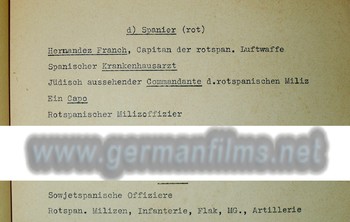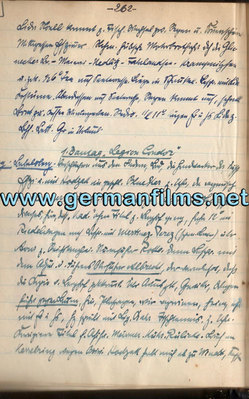- Home
- POSTER GALLERY
- ❗️BOOK & POSTER STORE❗️
- About the Posters
- The William Gillespie Collection
- Our Publishing House
- ❗️GFDN interviews author and collector William Gillespie ❗️
- Our most expensive & inexpensive finds!
- ❗️***NEW!*** Poster of the Month ❗️
- ❗️NEW ❗️Film Posters – Demands on an important means of film advertising. ❗️
- In our Book + Zeitschrift Library
- ❗️ ***NEW!*** Hitler Youth Quex – A Guide for the English–speaking Reader ***NEW!*** ❗️
- ❗️***NEW!*** Table of Contents of our new HJ QUEX book❗️
- ❗️Hitler Youth Quex Guide - early praise! ❗️
- Recent loans from the Collection
- Farewell Horst Claus. (1940–2024)
- "Der Deutsche Film" Zeitschrift
- ❗️ ***NEW!***German "Tendency" Films (Tendenzfilme) in the Third Reich ❗️
- KARL RITTER
- Karl Ritter original film posers in this Collection
- "Besatzung Dora" ( † 1943)
- "The Making of The Crew of the Dora"
- Karl Ritter at the 1938 Reichsfilmkammer Congress
- INDEX -"Karl Ritter" book, 2nd edition
- Karl Ritter's Legion Condor (1939, unfinished)
- Excerpt from our "Dora" book
- ∆∆∆∆∆ High praise for our DORA book! ∆∆∆∆∆
- TABLE OF CONTENTS – "Legion Condor"
- § § § § § Early Praise for our LEGION CONDOR book! § § § § §
- ❗️"Das Leben geht weiter" and Karl Ritter ❗️
- Zarah Leander Europe–wide !
- Japan Military Film and Karl Ritter
- Karl Ritter after 1945
- 1935 Film Congress
- Poster Exhibition in Berlin, March 1939
- Potsdam poster exhibition 12 April–25 August 2019
- Leni Riefenstahl's two "Olympia" Films (1938)
- "Ohm Krüger" (1941)
- Emil Jannings
- "Blutendes Deutschland" (1933)
- Hannes Stelzer ( † 1944)
- Klaus Detlef Sierck ( † 1944)
- Film stills
- Reich Film Censorship Offices
- ❗️Dateline: Ufa - April 11, 1945 ❗️
- ❗️***NEW!***The Fate of the German Film Industry in May 1945 ❗️
- Film censorship cards
- Film Archives
- Cinema advertising
- School filmstrips
- ❗️UPDATED❗️ Z F O / Ostland Film G-m-b-H
- Z F O / Herbert Jacobi estate
- ZFO / Ostland Film newspaper articles
- ❗️***NEW!*** Roter Nebel / Red Fog / Red Mist (1942/1943, ZFO) ❗️
- ZFO - Der Rückkehrer - The Returnee (1943/1944)
- The D F G production company
- D I F U
- ❗️ ***NEW!*** "Carl Peters" – Special Collection. ❗️
- "Alcazar" (1940, Genina)
- "Der 5. Juni" (1943, banned)
- ❗️ ***NEW!*** Herbert Selpin and his "Titanic" (1943) ❗️
- ❗️ ***NEW!*** Ein Robinson (1940, Fanck) ❗️
- "Fronttheater" (1942)
- Veit Harlan's Jud Süß and Fritz Hippler's Der Ewige Jude
- Harlan "Jud Süß" trial 1949
- Werner Krauss & JUD SÜß
- Anti-Semitic Film Posters in the Collection
- "Heimkehr" (1941)
- "Hitlerjunge Quex" (1933)
- ❗️***NEW!*** Hitlerjunge Quex in 111 Greater Berlin Cinemas ❗️
- Jürgen Ohlsen
- "S.A.Mann Brand" (1933)
- "In der roten Hölle" (Edgar Neville, 1939)
- "Helden in Spanien" (1938)
- The Spanish Civil War in Film
- Andrews Engelmann (1901 – 1992)
- Deutsche Wochenschau
- Uƒa Feldpost
- Uƒa Kulturfilm – Informationen
- " Die Tochter des Samurai" (1937, Fanck)
- Ufa 25th Anniversary
- Invitations to world premieres
- ❗️***NEW!*** Continental Films, Paris 1940–1944 ❗️
- Film Censorship in Occupied Paris 1942
- "Der Sieg des Glaubens" (1933)
- Wilhelm Althaus Estate
- Weimar Germany posters
- Ufa and the Ordensburgen
- The Gaufilmstelle in our Collection
- "Zwei Welten" (1940)
- "Capriccio" (1938) –Karl Ritter film album
- Unrealised NS Propaganda Films 1934–1945
- German Film Directors accused of "war crimes"
- Australian––themed NS feature films
- "Der Störenfried" / "The Troublemaker"
- What was new in 2014?
- What was new in 2015?
- What was new in 2016?
- What was new in 2017?
- What was new in 2018?
- What was new in 2019?
- What was new in 2020?
- What was new in 2021?
- What was new in 2022?
- What was new in 2023 ?
- What's new in 2024?
- ❗️***NEW!*** Hitler assassination attempt in Karl Ritter film cut❗️
- BESATZUNG DORA private photos
- Just discovered 1942 article on BESATZUNG DORA
- The Karl Ritter Tetralogy
- Google Analytics 2023
- Our first–ever acquisition!
- ❤️"Some of our favourite things....!"❤️
- ERRATUM for our " Hitler Youth Quex Guide"
- Trending
- Vale †
- Our Wants List / 2024 / Wunschliste
- Pop Quiz
- Unsere KARL RITTER Bücher in Deutschland liefbar!
- WHERE to buy our books right now?
- ✉️Contact
 “History is not about the facts. It is about the context and who is telling the story.” —Prof. Milton Fine.
“History is not about the facts. It is about the context and who is telling the story.” —Prof. Milton Fine.
"Who controls the past controls the future: who controls the present controls the past." –– George Orwell in his novel "1984."
"Whoever doubts the exclusive guilt of Germany for the Second World War destroys the foundation of post–war politics." –– Prof. Theodor Eschenberg, Rector, the University of Tübingen.
"If we have our own why in life, we shall get along with almost any how." – Friedrich Nietzsche
POSTER GALLERY --view
over 500 German film
original posters between
1927–1954 from
Germany and from
many Axis and Neutral countries
across Europe!
Note! Posters in the Poster Gallery are PERMANENT
acquisitions which are NOT FOR SALE!! ONLY the
posters listed in our POSTER STORE are for sale.
(They have a price and order button to use.)
KARL RITTER’S UNFINISHED FEATURE FILM LEGION CONDOR (1939).
The long believed lost film script found after 80 years !
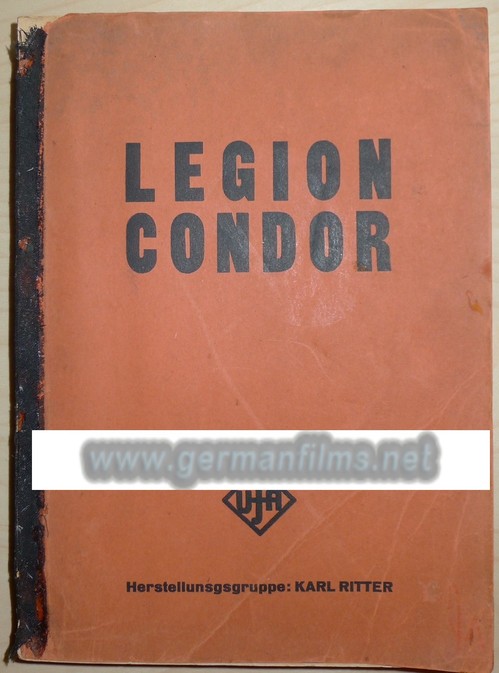
"You did not find the film script -- it
found you!"
After the huge box office success and critical acclaim for his 86 minute long documentary film Im Kampf gegen den Weltfeind (In Battle against World Enemy Nr. 1) Karl Ritter wrote a film script for a feature film on the Spanish Civil War. It was meant to be an actual sequel to his 1938 smash hit, Pour le Mérite, starring Paul Hartmann, Fritz Kampers, Albert Hehn, Carsta Löck, and a cast of over one hundred actors. Many of these same leading actors were thus contracted to appear in Legion Condor. The set construction at the Ufa Babelsberg studios was completed by early August. The first scenes were filmed there with a cast of over 200 extras appearing as victorious soldiers fighting for Franco. Filming started on 8 August and ran for fifteen days. But on 25 August, Ritter was told to halt all further filming. “World political events” were mentioned to him confidentially by the government. The von Ribbentrop-Stalin Pact had been signed and no anti-Bolshevist film such as Legion Condor was possible during the life of the infamous Pact. Ritter’s other anti–Russian film, Kadetten, which had been scheduled to have its world premiere at that year’s Nürnberg Party Day Rally, was also cancelled; as was the Rally itself once the Polish campaign started that week.
The film was actually announced in the 1939/1940 Ufa season preview book for cinema owners. The German poster design was shown in the preview book; which we published in full colour in our KARL RITTER book.
The catalogues of the German federal film archives, the Berlin Kinemathek-Film Museum, the nation-wide German library portal, and those associated with leading university collections all fail to show a copy of this film script in their respective collections. Three renowned German film historians, as well as the German and Austrian film archives, have all unanimously confirmed to us that no Legion Condor script other than ours exists in any known collection.
In July 2018 we purchased from a used bookstore in Germany the original Ufa film script for Legion Condor, shown above. This was an extraordinary discovery. Had we not discovered this lost film script, someone else would have and it could have disappeared into a private collection and remained totally unknown to the outside world. As one of our closest German film historians commented when he heard of our purchase, "You did not find the film script -- it found you!" Indeed, after researching and publishing two books devoted to Karl Ritter in terms of the first biography on him published, and the only book to deal with his forbidden war film, Besatzung Dora (1943), we believed that we had exhausted any possibility of delving back into this area of research again. Now we are drawn to this Project as a unique opportunity to learn and publish much more about this never-completed, politically unwanted film caught up at the time of the beginning and duration of the von Ribbentrop-Stalin Pact.
We are gathering scattered information and have found a few more references to the film in our extensive German film library of original books,marketing, promotional materials and newspapers. This effort, in late northern Summer/Fall 2018 during a research trip to Europe, has allowed us to gather all known newspaper articles, background information, and scans of twelve press photos , to commence work on a monograph on Legion Condor.
We shall use this webpage on the film to present further research, as possible.
-----
There is so little material about the film extant that film historians as early as the 1960s were making errors in discussing it. Typical were the dates of filming given as from „early August“ to 1 September. We know from Karl Ritter's diaries that it was just a 15 day film shoot before the production was pulled — that is, from 8 to 25 August.
The English-language Wikipedia erroneously gives Legion Condor a "Release date: June 15, 1939" and "the film was pulled from Distribution in August 1939 to avoid offeding the Soviets who had supported the other side in Spain and who were negatively portrayed in the film." This mix-up with Ritter's Im Kampf gegen den Weltfeind is inexcusable. That Weltfeind had a Release date of June 15th and that it was indeed pulled from cinemas in August that year proves that the two film titles have been confused by Wikipedia contributors. (We have submitted a correction to this Wiki page, so hopefully the Facts will prevail.)
The highly regarded book Propaganda Documentaries in France 1940–1944, by Jean-Pierre Bertin–Maghit (Rowan & Littlefield, London, 2016) mentions German documentary films such as Feldzug in Polen shown in Occupied France and states on page 121...."and the unfinished Im Kampf gegen den Weltfeind (about German volunteers in Spain), which should have demonstrated implacable German efficiency." Once again, a Ritter documentary film (and one which was completed and released in Summer 1939!) confused with his abandoned feature film Legion Condor.
There has never been a plot summary longer than one or two sentences for the film, which is that of a heroic hymn to the German Legion Condor men who supported Franco. Now we have the full script to tell the full story.
Wikipedia entries on the film have stated that the cancellation of the film cost RM5,500,000-; which is an enormous sum. To put this in context, the sumptuous, hugely expensive Agfacolor classic Münchhausen, full of incredible special effects and top-paid actors, cost RM 6,475,000- . So a B/W military film run on a Ritter tight budget, for which he was famous, was far less expensive. The budget was RM 916,000- and the Ufa studio Board minutes of 22 August 1939, three days before the production was stopped, reported that it had cost RM400,000- up to that day. A late 1939 report about film productions cancelled or forbidden because of the war, written for Dr. Goebbels by Ufa‘s master financier, Dr. Max Winkler, lists the loss attributed to Legion Condor at RM550,000.- (that is 1/10th of the loss stated in Wikipedia......).
Another example of poor information: ImdB has only five actors named with their military ranks assigned to them in the flm, but not the actual character names, such as "Paul Hartmann, Commander of the Jagdflieger." We know him now as Major Paul Hagen, Commander of the Jagdflieger. Our research will provide more information about this film than has ever been known since 1940; just as our book on Besatzung Dora told it‘s story in full for the first time.
Onwards and upwards!
-------
The film plot, as told for the first time since the film was abandoned in August 1939:
1. Opening credits —A Legion Condor flag waving in the breeze, with Falangist Anthem playing. Music fades out with credits.
2. Daytime, a Madrid street. The Communist „Internationale“ anthem playing. A car with four men pulls up to an apartment building, they storm up the stairs, push their way violently into the apartment and shoot a man sitting at his desk.
3. A large meeting room in a Madrid. „Internationale“ continues playing. A Communist speaker declares to a jubilant crowd that the fascist Calvo Saleto is no more, and that the international proletariat knows how to fend off its enemies. Crowd cheers.
4. Madrid street scene. „Internationale“ continues on soundtrack. Panicked crowds run through the streets, fighting breaking out, store windows smashed, chaos.
5. Madrid church interior. „Internationale“ continues playing. Huddled church goers in the church interior shadows. A smiling Madonna with child statue on the wall over the crowd. Suddenly a shot rings out and blasts the arm of the Madonna off, a second shot rips the smile off her face.
6. Montana Caserne, The „Internationale“ continues playing. Ten Falangists are put up against the wall and executed by Red soldiers. (“Internationale“ fades out.)
7. Walled window in the Tetuan District of Madrid. Twenty Spanish Nationalist officers repeat Franco‘s words in unison: „We are ready to die for Spain.“ An officer says to them: „Men, be ready to do so, too!“
8. Ground in front of a Spanish city. A Red machine gun nest and defensive position. Grenades explode, machine gun fire from left to right, a Nationalist battery fires into the area and city.
9. German officers‘ quarters of Fighter pilots, in Germany. Officer looking at a wall map, one says: „My word! That looks horrible. Half of Spain lost!“. This scene is the first in which the Squadron Commander, Luftwaffe Major Paul Hagen, appears; as portrayed by actor Paul Hartmann.
10. An airfield in Germany. (Men told to go to their aircraft to fight for Franco.)
All these scenes are each only one or two pages of film script in length. Most end with a „Harte Schnitt“ or hard cut away. Tight editing and camera work. Typical Karl Ritter fast–paced action as per other „Zeitfilme“ such as GPU. The first 8 scenes are covered in just the first 15 pages. The script is 283 pages long.
TO BE CONTINUED.....
in our forthcoming monograph, to be published by German Films Dot Net in Summer 2019. The monograph has a working title of LEGION CONDOR ---Karl Ritter's lost 1939 feature film. As a pre-publication, it has been issued ISBN # 978 –0–9808612–6–6.
We have received courtesy of Karl Ritter's grandson all of the 1939 diary pages pertinent to the writing, preparation and filming of Legion Condor before it was stopped in late August 1939, thanks to the von Ribbentrop–Molotov Pakt making such an anti–Bolshevik film unwanted during this uneasy truce between the Third Reich and the USSR. These diary pages, just as was the case for our previous two books on Karl Ritter, have never been translated into English 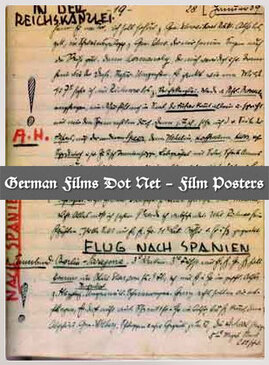 or published before. This adds absolute authenticity from Karl Ritter in his own words. Combined with our discovery and use of the film's long–lost script, Ritter's diary entries make the forthcoming monograph very special and unique indeed. We estimate that the book will be about 180–200 pages long, with over 125 footnotes, as well as 38 B&W illustrations/photos and 4 colour plates. It will be in the same 6 x 9 inch paperback format as our previous two Karl Ritter books; making a Karl Ritter trilogy of a combined 800+ pages, almost 600 footnotes, and nearly 200 B&W photographs/ illustrations as well as 24 full–colour plates between the three books.
or published before. This adds absolute authenticity from Karl Ritter in his own words. Combined with our discovery and use of the film's long–lost script, Ritter's diary entries make the forthcoming monograph very special and unique indeed. We estimate that the book will be about 180–200 pages long, with over 125 footnotes, as well as 38 B&W illustrations/photos and 4 colour plates. It will be in the same 6 x 9 inch paperback format as our previous two Karl Ritter books; making a Karl Ritter trilogy of a combined 800+ pages, almost 600 footnotes, and nearly 200 B&W photographs/ illustrations as well as 24 full–colour plates between the three books.
Update @ 17 March 2019: The book page tally comes to 244 pages, with 126 footnotes, 38 B&W photographs and 4 full-colour poster plates. The photographs include 12 never-before-seen Ufa press photos taken of the scenes in Legion Condor which managed to be shot before production abruptly ended on 25 August 1939. The book is in print and is now available for sale.
Do you know that the German government kept the involvement of the Condor Legion in Spain an official "top secret" until the men had arrived safely back on German soil (in Hamburg)? The mention of the Condor Legion's name was forbidden in German print until May 25,1939. In the years of the Legion's presence in Spain during the Civil War there, a cover address for the Condor Legion airmen and support staff to use was a post office box in Berlin, and the name associated with it was a Max Winkler. That was the men's "return address" as if they were still in Germany. Their families could not be told their deployment destination, their role there, how long they would be away from home, or anything else about their absence. That was often for many months. We have in our Collection a letter and envelope from an airman addressed to his mother, with the Winkler return address rubber-stamped on the back. These letters are today extremely scarce. We reproduced this letter's image in our book in B&W:
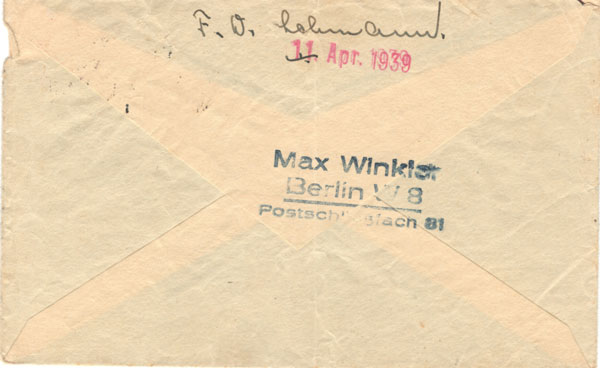
Here is the Table of Contents of the book:



